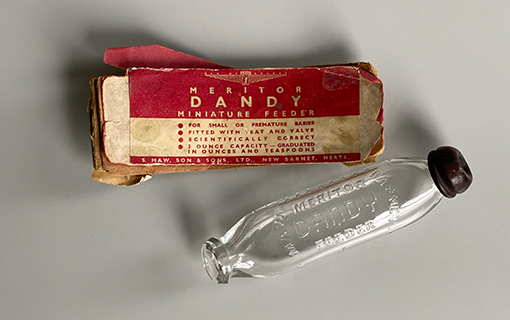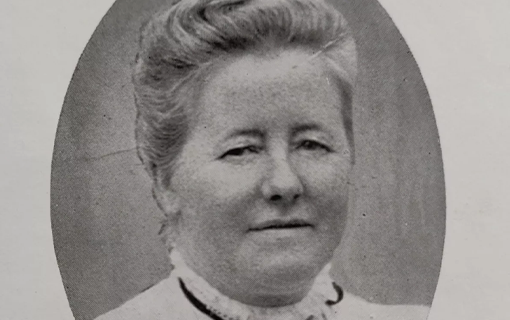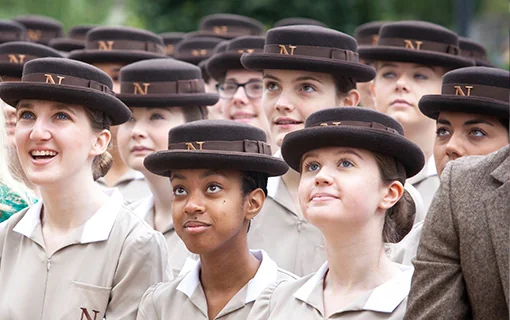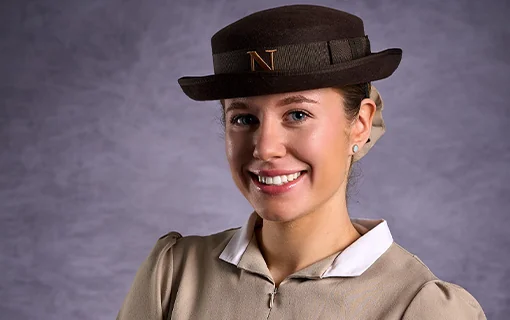The history of Norland in 13 objects: a baby's bottle from the 1910s
20 March 2023

The eleventh object in our series of 13 archival objects celebrating Norland’s 130-year history is a baby’s bottle from the 1910s. The glass object would have been used by early Norlanders to feed their charges and offers us an understanding of the context of early years childcare at the time of Norland’s foundation. This article has been written by Ainur Meirbekova, an education researcher based at the University of Bristol and Norland Graduate Research Intern.
Ainur has an MSc in Inclusive Education. She worked with primary children at Haileybury Almaty School, Kazakhstan before training as a Montessori early years teacher. Ainur is currently a doctorate researcher at the University of Bristol exploring creative thinking of young children in different learning environments. She completed her Graduate Research Internship at Norland in 2022.
“My Graduate Research Internship (GRI) project at Norland aimed to critically evaluate and understand the vision and work of Emily Ward within the historical context of the time. Through exploring the contours of socio-economic, political, and educational landscapes of the time of Norland’s foundation in 1892 and up to 1930 when Emily Ward died, I hoped to understand how these influences shaped Emily Ward’s vision and the course of her actions.
“It is important to recognise Norland’s unique historical path, and the context in which it has its foundations. We might not realise when viewing history, the underlying mechanisms, historical premises and processes which influence how developments take place. As a result, my GRI project revealed some major historical aspects, which will be discussed below.

“I have chosen the object of a baby’s bottle from the early Edwardian era from the Norland archives as it provides insight into best practice for early years childcare at the time and acts as a visual example of industrialisation at the time. With the coming of industrialisation, working mothers no longer had time to breastfeed their babies as regularly as in previous years, nor could many afford wet nurses.
“Norland was established during the reign of the Queen Victoria, a period marked by significant socio-economic, political, and educational changes in Britain that would shape the course of history for decades to come. One of the key developments was a rapid industrialisation which entailed considerable effects in many other fields. New technologies and manufacturing techniques led to increased productivity and a shift in the nature of work, which led to an increasing number of people requiring childcare, or easier methods of providing for their children’s basic needs.
“Prior to 1894, baby bottles were a dangerous contraption. The ‘murder bottle’ of previous years had an unhygienic hose attachment, which led to many unexplained baby deaths. However, these designs were revised and bottles similar to the ones used today came into circulation. In 1894 the first ‘banana’ shaped feeder, the Allenburys’ feeder, appeared on the market. Made by the partnership of Allen and Hanburys, it was advertised as being “most easily cleansed” and quickly became popular. Other companies soon followed the example.
The bottle shown above is the ‘Meritor Dandy’ Miniature Feeder, dating from the early 1910s. The bottle is made from clear moulded glass and has a flat base to keep it stable on a surface. It is boat shaped and fits neatly into one hand, allowing the other hand to support the baby. At one end of the bottle there is a hole for pouring in the feeding mixture. To prevent it from pouring out, a metal cap is put on after filling. At the other end a similar hole, covered by a rubber teat, lets the baby suck out the feed. The teat regulates the flow of liquid into the baby’s mouth, ensuring it does not drink too fast and choke. This bottle was designed for small or premature babies and has a two-ounce capacity.

“Industrialisation resulted in the rise of the middle class and a growing gap between the rich and the poor, as a small number of wealthy industrialists and capitalists amassed vast fortunes while many working people struggled to make a living wage. The rise of the middle class led to a growing demand for domestic servants, including nursemaids who would care for children.
“Politically, Britain saw the rise of the Labour Party, which advocated for the rights of working-class people, as well as the rise of the women’s suffrage movement which fought for the rights of women to vote. The movement officially began in 1903 with the creation of the Women’s Social and Political Union by Emeline Pankhurst. At the time, women had limited rights. The suffragette movement had strong support among middle and upper-class women and helped to shape women’s education and professional opportunities.
“Emily Ward based her childcare philosophy on the works of Friedrich Froebel. At the centre of his teaching was the idea that “motherly instincts” are not just engendered by mere “good feeling” but must be harnessed through quality education and training that centred around love for the child. At the time, female education was subordinate to male education, so Froebelian pedagogy was ground-breaking given its contexts. Emily Ward sought to create a new profession for women based on this approach, giving a new class of women independent social mobility.
“Emily Ward was always supportive of the less advantaged. In 1907, she established the first crèche for working-class children which allowed working women to leave their children to professionals (the photograph shows Norland students with children from the Norland crèche). As a response to industrialisation, the demand for specialists with distinctive manual qualifications and the women’s rights movement, she initiated workrooms for dressmaking where used clothes would be repurposed by employed women.
“Alongside the growth of the middle class and the rise of democracy, there was a growing expansion of the school system and emphasis on compulsory education. Industrialisation and the extension of cities created a need for a skilled workforce which also influenced the content of the curriculum being taught at schools. Nevertheless, education was still guided by gender differences and social class, so less advantaged children did not have the opportunity to receive a proper education. This was worsened by the common use of corporal punishment at the time, and the trend towards a more authoritarian parenting and childcare style that focused on discipline and obedience.

“The events in Britain in the late 19th and early 20th century had a significant impact on Emily Ward’s actions, and specifically Norland’s lasting vision. Continually influenced by Froebel, Mrs Ward (shown on the left in the photograph with Norland’s first Principal Isobel Sharman) believed that children should be viewed as individuals with unique needs and abilities, and that they should be given freedom to explore and discover the world around them. Unlike the common approach to focus primarily on the physical wellbeing of children, she also believed that education should nurture the whole child, rather than just focusing on one aspect of its development.
“This vision of a child and approach to education was revolutionary. It challenged the traditional authoritarian model and led to the establishment of Norland – the first ever institution to provide formal early years training and the creation of a new profession: the trained nursery nurse. It also became the foundation for Norland’s curriculum, which continues today to offer a unique blend of cutting-edge early years knowledge alongside practical skills and extensive hands-on experience.
“Emily Ward was a trailblazer in the field of early childhood education transforming the vision and perception of a child and laying the foundations for the modern profession of early years educator. Moreover, she was a strong advocate for the education and professional development of women. During a time when opportunities for women were limited, she saw the importance of supporting women and her work opened new career and educational opportunities for them. It is also important to acknowledge the history of early childhood education in general as well as specifically Norland’s history, which will help educators and policymakers to understand the context of the early years field and to make informed decisions about its future.”








